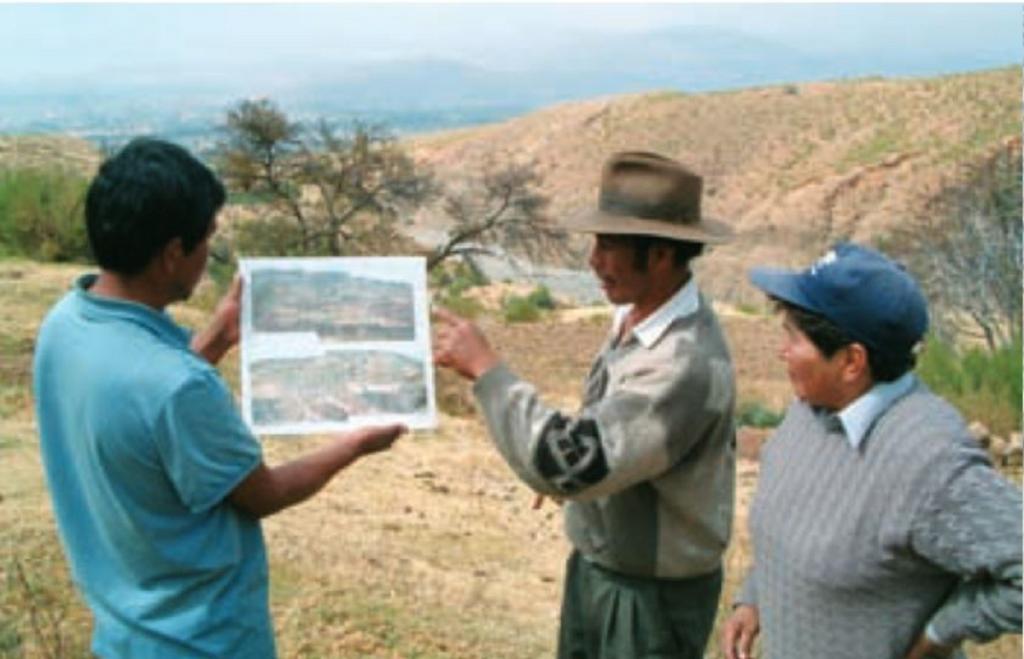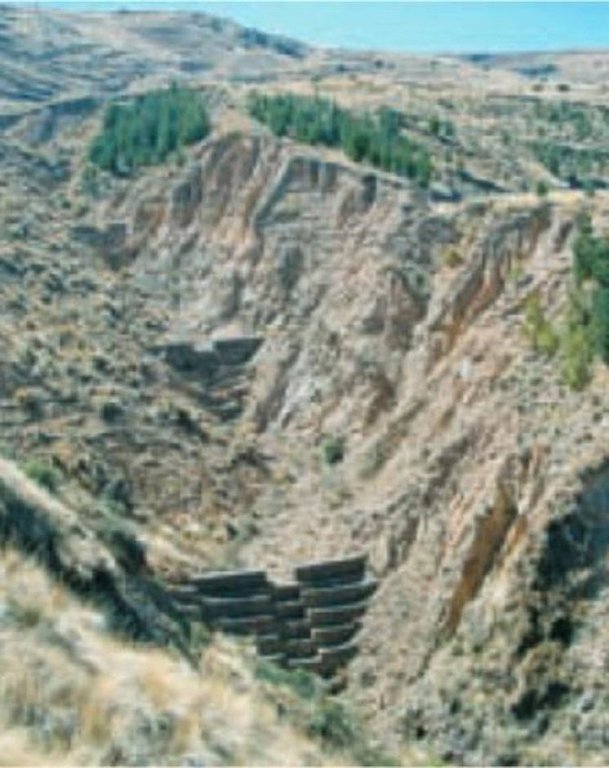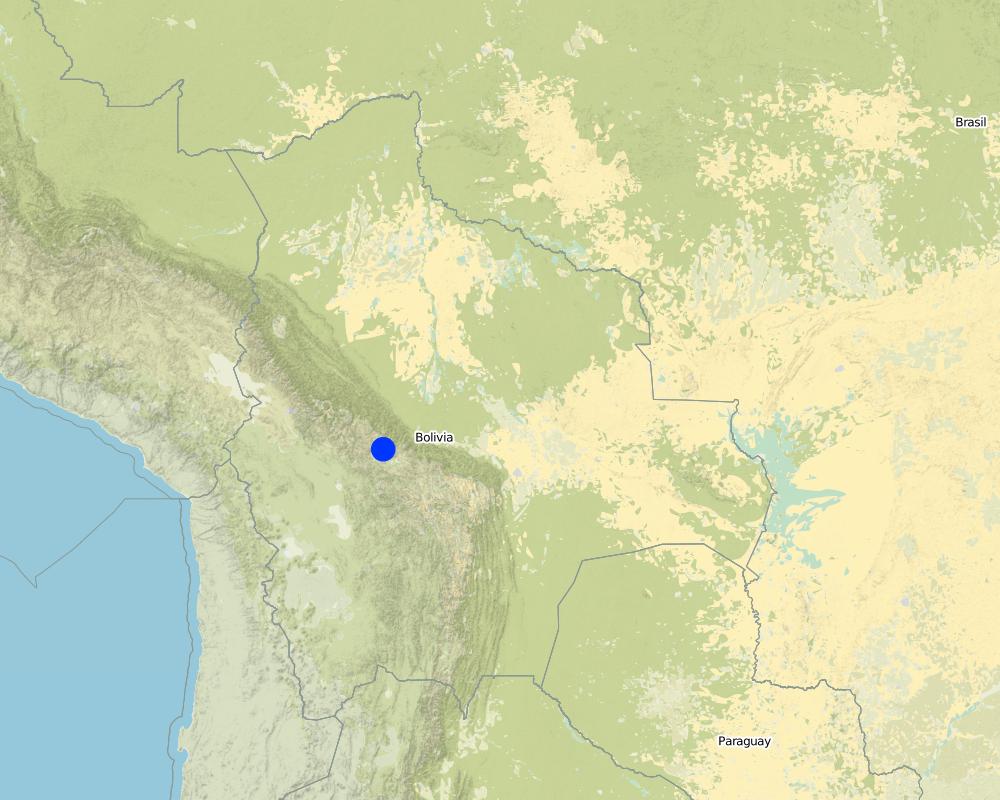Incentive-based catchment treatment [ບໍລີເວຍ, ລັດພູລິເນຊັນນໍ]
- ການສ້າງ:
- ປັບປູງ:
- ຜູ້ສັງລວມຂໍ້ມູນ: Unknown User
- ບັນນາທິການ: –
- ຜູ້ທົບທວນຄືນ: David Streiff, Deborah Niggli
approaches_2404 - ບໍລີເວຍ, ລັດພູລິເນຊັນນໍ
ເບິ່ງພາກສ່ວນ
ຂະຫຍາຍທັງໝົດ ຍຸບທັງໝົດ1. ຂໍ້ມູນທົ່ວໄປ
1.2 ລາຍລະອຽດ ການຕິດຕໍ່ ຂອງບຸກຄົນທີ່ຊັບພະຍາກອນ ແລະ ສະຖາບັນ ການມີສ່ວນຮ່ວມ ໃນການປະເມີນຜົນ ແລະ ເອກະສານ ຂອງວິທີທາງ
ຜູ້ຊ່ຽວຊານ ດ້ານການຄຸ້ມຄອງ ທີ່ດິນແບບຍືນຍົງ:
ຊື່ຂອງໂຄງການ ທີ່ອໍານວຍຄວາມສະດວກ ໃນການສ້າງເອກກະສານ ຫຼື ປະເມີນດ້ານແນວທາງ (ຖ້າກ່ຽວຂ້ອງ)
Book project: where the land is greener - Case Studies and Analysis of Soil and Water Conservation Initiatives Worldwide (where the land is greener)ຊື່ຂອງ ສະຖາບັນການຈັດຕັ້ງ ທີ່ອໍານວຍຄວາມສະດວກ ໃນການສ້າງເອກກະສານ ຫຼື ປະເມີນແນວທາງ (ຖ້າກ່ຽວຂ້ອງ)
GEOTEST AG (GEOTEST AG) - ສະວິດເຊີແລນ1.3 ເງື່ອນໄຂ ຂອງການນໍາໃຊ້ເອກກະສານຂໍ້ມູນ ຂອງ WOCAT
ຜູ້ສັງລວມ ແລະ ບັນດາຜູ້ຕອບແບບສອບຖາມ ຍອມຮັບໃນເງື່ອນໄຂ ການນໍາໃຊ້ຂໍ້ມູນເອກະສານ ທີ່ສ້າງຂື້ນ ໂດຍຜ່ານ ອົງການ WOCAT:
ແມ່ນ
1.4 ເອກະສານອ້າງອີງ (ຫຼາຍ) ກັບແບບສອບຖາມ (ຫຼາຍ) ເຕັກໂນໂລຢີ ຂອງດ້ານການຄຸ້ມຄອງ ດິນແບບຍືນຍົງ

Diques de piedras [ບໍລີເວຍ, ລັດພູລິເນຊັນນໍ]
Se trata de diques de piedras que se ubican en el lecho de los arroyos, acompañados por plantaciones alrededor de las construcciones.
- ຜູ້ສັງລວມຂໍ້ມູນ: Unknown User

Zanjas de Coronación [ບໍລີເວຍ, ລັດພູລິເນຊັນນໍ]
Las zanjas de coronación impiden la entrada del escurrimiento superficial a las cárcavas
- ຜູ້ສັງລວມຂໍ້ມູນ: Unknown User
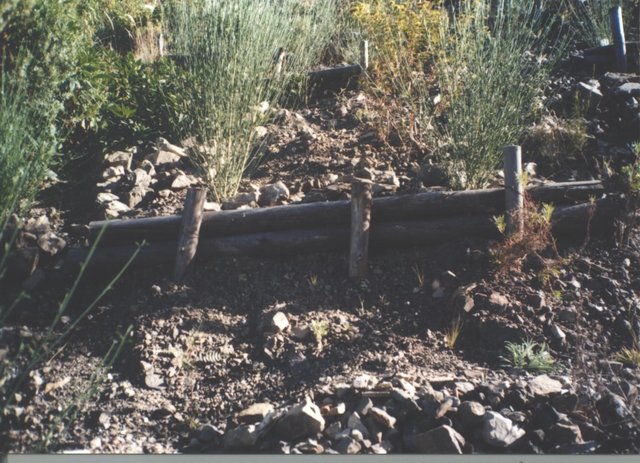
Estabilización de taludes (biotrampas) [ບໍລີເວຍ, ລັດພູລິເນຊັນນໍ]
La tecnología consiste en la práctica de reforestación en combinación con el establecimiento de trampas de sedimentos (biotrampas) para consolidar los taludes.
- ຜູ້ສັງລວມຂໍ້ມູນ: Georg Heim
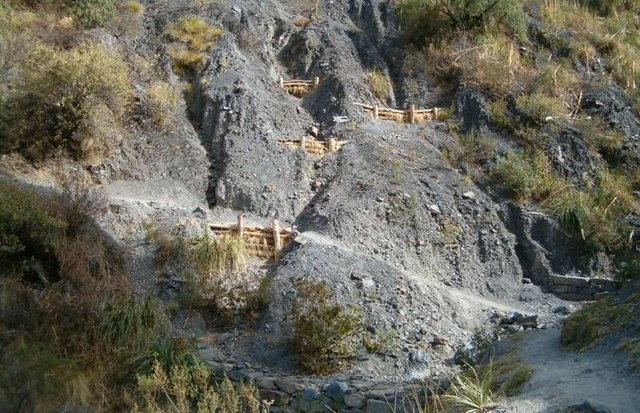
Gully control and catchment protection [ບໍລີເວຍ, ລັດພູລິເນຊັນນໍ]
Integrated gully treatment consisting of several simple practices including stone and wooden check dams, cut-off drains and reforestation in sediment traps (biotrampas).
- ຜູ້ສັງລວມຂໍ້ມູນ: Georg Heim
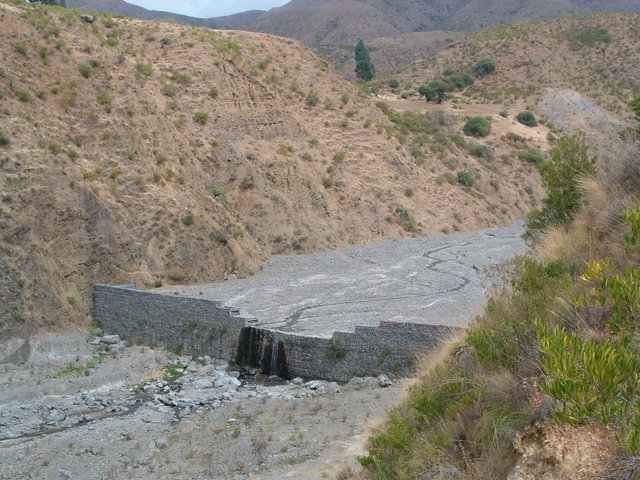
Obras Hidráulicas - Gaviones de Piedras [ບໍລີເວຍ, ລັດພູລິເນຊັນນໍ]
Mampostería gavionada (= gaviones puestos en el cauce). Se trata de paquetes de piedras encajadas en malla de alambre que forman una represa de sedimentos.
- ຜູ້ສັງລວມຂໍ້ມູນ: Georg Heim

Diques de madera (tipo Krainer) [ບໍລີເວຍ, ລັດພູລິເນຊັນນໍ]
Se trata de diques de madera que se ubican en el lecho de los arroyos, acompañados por plantaciones alrededor de las construcciones.
- ຜູ້ສັງລວມຂໍ້ມູນ: Georg Heim
2. ພັນລະນາ ແນວທາງການຄຸ້ມຄອງນໍາໃຊ້ດິນແບບຍືນຍົງ
2.1 ການອະທິບາຍ ໂດຍຫຍໍ້ ຂອງວິທີທາງ
A project supported, incentive-based approach: farmers are sensitised about erosion, and involved in gully control and other measures to protect catchments.
2.2 ການອະທິບາຍ ລາຍລະອຽດ ຂອງວິທີທາງ
ການອະທິບາຍ ລາຍລະອຽດ ຂອງວິທີທາງ:
Aims / objectives: The objective of the locally-based organisation Programa de Manejo Integral de Cuencas (PROMIC) is to involve land users in the control of soil erosion in the catchments above Cochabamba city. While erosion here is largely a natural process, it is aggravated by inappropriate agricultural practices. PROMIC receives funds from national and international governments, and works in an interactive manner. Together with local farmers, erosion processes in the context of the human environment were analysed to identify the needs of the agriculture population - and to plan a conservation and development programme. The aim was to convince farmers of the necessity to protect their agricultural land and stabilise the gullies below, and of the overall importance of implementing technologies to combat erosion.
Role of stakeholders: The farmers were involved in the process through regular community meetings organised by PROMIC, in which they could adjust PROMIC's catchment intervention plans to their own requirements through an interactive process. PROMIC considered that the sensitisation work and the interactive process were essential to ensure long-term sustainable land use. In the short term, however, it will be mainly the city downstream - Cochabamba - that benefits from the implementation of the erosion control technologies. For that reason, the farmers were paid to carry out construction of the measures (through 'cash-for-work'). The farmers should, however, profit from the technologies in the long term. They were taught how to build and maintain check dams, cut-off drains and biotrampas. The implementation in the watershed started in 1996 and took six years: when the implementation phase was over, farmers no longer received financial subsidies. The long period of sensitisation should help to ensure that farmers incorporate erosion prevention technologies into their cropland above the gullies. PROMIC still monitors the state of the structures from time to time, but most of the maintenance is left to the farmers themselves. PROMIC continues, however, to provide technical support and some transport of materials. Both internal and external evaluation followed the end of the implementation phase.
2.3 ຮູບພາບຂອງແນວທາງ
2.5 ປະເທດ / ເຂດ / ສະຖານທີ່ບ່ອນທີ່ແນວທາງໄດ້ຖືກນໍາໃຊ້
ປະເທດ:
ບໍລີເວຍ, ລັດພູລິເນຊັນນໍ
ພາກພື້ນ / ລັດ / ແຂວງ:
Cochabamba district
Map
×2.6 ວັນທີເລີ່ມຕົ້ນ ແລະ ສິ້ນສຸດ ການຈັດຕັ້ງປະຕີບັດ ວິທີທາງ
ສະແດງປີຂອງການເລີ່ມຕົ້ນ:
1996
2.7 ປະເພດຂອງແນວທາງ
- ພາຍໃຕ້ໂຄງການ / ແຜນງານ
2.8 ເປົ້າໝາຍ / ຈຸດປະສົງຫຼັກ ຂອງການຈັດຕັ້ງປະຕິບັດ ວິທີທາງ
- teach farmers about sustainable land use, - build up skills amongst farmers to enable them to treat gullies without outside help, - reduce flooding and sedimentation in the valley of Cochabamba and general soil loss in the area through collaboration with farmers in the watershed, - improve traditional agriculture with a package of conservation-related practices, - indirectly support farmers by cash-for-work incentives which enables them to implement SWC technologies on their own fields
The SLM Approach addressed the following problems: - lack of knowledge about damage caused by erosion and benefits of various possible conservation technologies, - lack of financial resources: shortage of funds prevents farmers investing in technologies, even if these bring benefits to them (as well as to the downstream population), - persistence of detrimental traditional agricultural practices, leading to accelerated degradation
2.9 ເງື່ອນໄຂອໍານວຍ ຫຼື ຂັດຂວາງການປະຕິບັດຂອງເຕັກໂນໂລຢີ / ເຕັກໂນໂລຢີການນໍາໃຊ້ຕາມແນວທາງ
ມີຄວາມສາມາດ / ເຂັ້າເຖິງຊັບພະຍາກອນດ້ານການເງິນ ແລະ ການບໍລິການ
- ເຊື່ອງຊ້ອນ
Few direct short-term profits from SWC technologies in gullies for the farmers in the watershed (the main beneficiary is the city of Cochabamba downstream).
Treatment through the SLM Approach: Search for national and international subsidies to help the farmers to implement the technologies during the initial period.
ການກໍ່ຕັ້ງສະຖາບັນ
- ເຊື່ອງຊ້ອນ
The local farmers' association is insufficiently organised to ensure the independent continuation of activities post-project.
Treatment through the SLM Approach: Local farmers' association should be included in the sensitisation and implementation process.
ອື່ນໆ
- ເຊື່ອງຊ້ອນ
Climate: Climatic extremes such as strong winds and excess or deficit of rain.
Treatment through the SLM Approach: Plant trees at close spacing, and plant trees/ shrubs that can tolerate climatic extremes.
3. ການມີສ່ວນຮ່ວມ ແລະ ບົດບາດຂອງພາກສ່ວນທີ່ກ່ຽວຂ້ອງທີ່ໄດ້ມີສ່ວນຮ່ວມ
3.1 ຜູ້ມີສ່ວນຮ່ວມ ໃນວິທີທາງ ແລະ ພາລະບົດບາດ ຂອງເຂົາເຈົ້າ
- ຜູ້ນໍາໃຊ້ດິນໃນທ້ອງຖິ່ນ / ຊຸມຊົນທ້ອງຖິ່ນ
There were no women working in the gully rehabilitation. The reason is a cultural taboo against women working with heavy materials; women are responsible for looking after cattle, and for the household.
- ອົງການຈັດຕັ້ງ ພາຍໃນຊຸມຊົນ
Local farmers association
- Specialised engineers of PROMIC
3.2 ການມີສ່ວນຮ່ວມຂອງຜູ້ນໍາໃຊ້ທີ່ດິນໃນທ້ອງຖິ່ນ / ຊຸມຊົນທ້ອງຖິ່ນໃນໄລຍະທີ່ແຕກຕ່າງກັນຂອງແນວທາງ
| ການລວບລວມ ເອົາຜູ້ນໍາໃຊ້ດິນ ໃນທ້ອງຖິ່ນ / ຊຸມຊົນທ້ອງຖິ່ນ | ໃຫ້ລະບຸ ຜູ້ໃດທີ່ມີສ່ວນຮ່ວມ ໃນແຕ່ລະກິດຈະກໍາ? | |
|---|---|---|
| ການເລີ່ມຕົ້ນ / ແຮງຈູງໃຈ | ການບໍ່ປະຕິບັດ | interviews/questionnaires, information during regular meetings, entrevistas / cuestionarios |
| ການວາງແຜນ | ການຮ່ວມມື | results of the socio-economic diagnosis defined the planning; farmers were involved through regular meetings: interactive planning at individual and community level |
| ການປະຕິບັດ | ການຊ່ວຍເຫຼືອຈາກພາຍນອກ | None |
| ຕິດຕາມກວດກາ / ການປະເມີນຜົນ | ການບໍ່ປະຕິບັດ | interviews/questionnaires; internal and external evaluations where farmers were interviewed |
| Research | ການບໍ່ປະຕິບັດ | socio-economic diagnosis; collection and analysis of bio-physical baseline data |
3.3 ແຜນວາດ (ຖ້າມີ)
ການອະທິບາຍ:
General assembly: National and international public and private institutions, members, foundation
Directory: Prefecture, general agent, Swiss Agency for Development and Cooperation (SDC), Belgian Technical Cooperation (BTC), private enterpreneurs
Consulting council: Municipalities, projects, universities
Advisors: General agent, marketing, SSU1, SSU2 (see below), administration
SSU: Strategic service unit
Services: Executive body for technology extension and implementation: PROMIC field technicians
3.4 ການຕັດສິນໃຈກ່ຽວກັບການຄັດເລືອກເຕັກໂນໂລຢີຂອງການຄຸ້ມຄອງທີ່ດິນແບບຍືນຍົງ / ເຕັກໂນໂລຢີ
ໄດ້ຕັດສິນໃຈເລືອກ ເຕັກໂນໂລຢີ (ຫຼາຍ) ບໍ່?
- Made by specialised engineers of PROMIC
ອະທິບາຍ:
farmers were involved by modifying initially proposed technologies.
Decisions on the method of implementing the SLM Technology were made by Made by specialised engineers of PROMIC
4. ການສະໜັບສະໜູນທາງດ້ານວິຊາການ, ການສ້າງຄວາມສາມາດ, ແລະ ການຈັດການຄວາມຮູ້.
4.1 ການສ້າງຄວາມສາມາດ / ການຝຶກອົບຮົມ
ຜູ້ນໍາໃຊ້ທີ່ດິນ ຫຼື ພາກສ່ວນກ່ຽວຂ້ອງອື່ນໆ ໄດ້ຮັບການຝຶກອົບຮົມບໍ່?
ແມ່ນ
ຮູບແບບຂອງການຝຶກອົບຮົມ:
- ການເຮັດຕົວຈິງ
ໃນຫົວຂໍ້:
The approach included training on technical aspects and on long-term planning for sustainable land use. Some farmers were trained to become foremen - who in turn instructed other farmers. During the construction period PROMIC project staff trained farmers on the job in soil conservation practices.
4.2 ການບໍລິການໃຫ້ຄໍາປຶກສາ
ເຮັດຜູ້ໃຊ້ທີ່ດິນມີການເຂົ້າເຖິງການບໍລິການໃຫ້ຄໍາປຶກສາ?
ແມ່ນ
ລະບຸວ່າການສະໜອງ ການບໍລິການ ໃຫ້ຄໍາປຶກສາ:
- ໃນພື້ນທີ່ຂອງຜູ້ນໍາໃຊ້ດິນ
ອະທິບາຍ / ຄວາມຄິດເຫັນ:
Name of method used for advisory service: participatory planning of gully treatment; Key elements: making farmers aware of the environmental and economic necessity for the technology, interactive planning of technology implementation at individual and community levels
4.3 ສະຖາບັນການສ້າງຄວາມເຂັ້ມແຂງ (ການພັດທະນາອົງການຈັດຕັ້ງ)
ສະຖາບັນ ໄດ້ຮັບການສ້າງຕັ້ງຂື້ນ ຫຼື ໄດ້ຮັບການສ້າງຄວາມເຂັ້ມແຂງ ໂດຍການຈັດຕັ້ງປະຕິບັດ ວິທີທາງບໍ່?
- ມີ, ພໍສົມຄວນ
ລະບຸ ທາງສະຖາບັນ ໄດ້ສ້າງຄວາມເຂັ້ມແຂງ ໃນລະດັບໃດ (ຫຼາຍ):
- ທ້ອງຖິ່ນ
ລະບຸ ປະເພດ ຂອງສະໜັບສະໜູນ:
- ການສ້າງຄວາມອາດສາມາດ / ການຝຶກອົບຮົມ
4.4 ຕິດຕາມກວດກາ ແລະ ປະເມີນຜົນ
ການຈັດຕັ້ງປະຕິບັດ ວິທີທາງ ໄດ້ມີການປະເມີນຜົນ ແລະ ຕິດຕາມບໍ?
ແມ່ນ
ຄວາມຄິດເຫັນ:
There were few changes in the Approach as a result of monitoring and evaluation: The approach was to initially target groups. Later, individuals were included (with individual farmer-family visits) to improve the effectiveness of the awareness raising and the implementation.
4.5 ການຄົ້ນຄວ້າ
ນີ້້ແມ່ນສ່ວນໜຶ່ງ ການຄົ້ນຄວ້າ ຂອງວິທີທາງບໍ່?
ແມ່ນ
ລະບຸ ຫົວຂໍ້:
- ສັງຄົມ
- ລະບົບນິເວດ
- ເຕັກໂນໂລຢີ
- S
ໃຫ້ຂໍ້ມູນ ເພີ່ມເຕີມ ແລະ ກໍານົດ ຜູ້ໃດເຮັດການຄົ້ນຄວ້າ:
Research was done on 1)SWC (testing different measures), 2)various soil parameters, and 3) a socio-economic survey. Research was an important part, not only for planning (based on biophysical and socio-economic data), but also to stay in contact with the rural population and to obtain their confidence. Thanks to the research, the technology is well adapted to the biophysical conditions.
5. ການສະໜັບສະໜູນທາງດ້ານການເງິນ ແລະ ອຸປະກອນຈາກພາຍນອກ
5.1 ງົບປະມານປະຈໍາປີ ສໍາລັບວິທີທາງ ຂອງການຄຸ້ມຄອງ ທີ່ດິນແບບຍືນຍົງ
ຄໍາເຫັນ (ຕົວຢ່າງ: ແຫຼ່ງຂໍ້ມູນຫຼັກ ຂອງການສະໜອງທຶນ / ຜູ້ໃຫ້ທຶນທີ່ສໍາຄັນ):
Approach costs were met by the following donors: government (national): 20.0%; international non-government: 80.0%
5.2 ການສະໜັບສະໜູນ ທາງດ້ານການເງິນ / ອຸປະກອນ ສະໜອງໃຫ້ແກ່ຜູ້ນໍາທີ່ດິນ
ຜູ້ນໍາໃຊ້ດິນ ໄດ້ຮັບການສະໜັບສະໜູນ ທາງດ້ານ ການເງິນ / ອຸປະກອນ ໃນການຈັດຕັ້ງປະຕິບັດ ເຕັກໂນໂລຢີບໍ?
ແມ່ນ
5.3 ເງິນສົມທົບສໍາລັບການນໍາໃຊ້ສະເພາະປັດໃຈຂາເຂົ້າໃນການຜະລີດກະສິກໍາ (ລວມທັງແຮງງານ)
- ແຮງງານ
| ທີ່ຂອບເຂດ | ລະບຸ ການອຸດໜູນ |
|---|---|
| ງົບປະມານເຕັມສ່ວນ | labour for the rehabilitation of the gully area |
- ອຸປະກອນ
| ໃຫ້ລະບຸໄດ້ຮັບການສະໜັບສະໜູນປັດໃຈຂາເຂົ້າຫຍັງແດ່ | ທີ່ຂອບເຂດ | ລະບຸ ການອຸດໜູນ |
|---|---|---|
| ເຄື່ອງກົນຈັກ | ງົບປະມານເຕັມສ່ວນ | |
| ເຄື່ອງມື | ງົບປະມານເຕັມສ່ວນ | |
- ກະສິກໍາ
| ໃຫ້ລະບຸໄດ້ຮັບການສະໜັບສະໜູນປັດໃຈຂາເຂົ້າຫຍັງແດ່ | ທີ່ຂອບເຂດ | ລະບຸ ການອຸດໜູນ |
|---|---|---|
| seedlings | ງົບປະມານເຕັມສ່ວນ | |
- ພື້ນຖານໂຄງລ່າງ
| ໃຫ້ລະບຸໄດ້ຮັບການສະໜັບສະໜູນປັດໃຈຂາເຂົ້າຫຍັງແດ່ | ທີ່ຂອບເຂດ | ລະບຸ ການອຸດໜູນ |
|---|---|---|
| ເສັ້ນທາງ | ງົບປະມານເຕັມສ່ວນ | community infrastructure |
| technical support | ງົບປະມານເຕັມສ່ວນ | |
- ອື່ນໆ
| ອື່ນໆ (ລະບຸ) | ທີ່ຂອບເຂດ | ລະບຸ ການອຸດໜູນ |
|---|---|---|
| transport for further technology implementation | ງົບປະມານເຕັມສ່ວນ |
ຖ້າແຮງງານ ຂອງຜູ້ນໍາໃຊ້ດິນ ໄດ້ຮັບການສະໜັບສະໜູນ ປັດໃຈຂາເຂົ້າ, ແມ່ນບໍ່:
- ຈ່າຍເປັນເງິນສົດ
ຄວາມຄິດເຫັນ:
100% of the implementation was subsidised. Farmers were contracted to build the structures
5.4 ສິນເຊື່ອ
ໄດ້ປ່ອຍສິນເຊື່ອ ສະໜອງໃຫ້ພາຍໃຕ້ ວິທີການສໍາລັບກິດຈະກໍາ ການຄຸ້ມຄອງ ທີ່ດິນແບບຍືນນຍົງບໍ່?
ບໍ່ແມ່ນ
6. ວິເຄາະຜົນກະທົບ ແລະ ສັງລວມບັນຫາ
6.1 ຜົນກະທົບຂອງແນວທາງ
ການຈັດຕັ້ງປະຕິບັດ ວິທີທາງ ສາມາດຊ່ວຍຜູ້ນໍາໃຊ້ທີ່ດິນ ໃນການຈັດຕັ້ງປະຕິບັດ ແລະ ບໍາລຸງຮັກສາ ເຕັກໂນໂລຢີ ການຄຸ້ມຄອງ ທີ່ດິນແບບຍືນຍົງໄດ້ບໍ?
- ບໍ່
- ມີ, ໜ້ອຍໜຶ່ງ
- ມີ, ພໍສົມຄວນ
- ມີ, ຫຼາຍ
The approach resulted in a considerable improvement in SWC. However, despite new knowledge about erosion, the farmers themselves hardly carry out any new gully conservation work without payment, and in the long term maintenance is not ensured.
Did other land users / projects adopt the Approach?
- ບໍ່
- ມີ, ໜ້ອຍໜຶ່ງ
- ມີ, ພໍສົມຄວນ
- ມີ, ຫຼາຍ
Some other projects in Bolivia have copied parts of PROMIC's approach.
6.3 ຄວາມຍືນຍົງຂອງກິດຈະກໍາວິທີທາງ
ຜູ້ນໍາໃຊ້ ທີ່ດິນ ສາມາດສືບຕໍ່ ການຈັດຕັ້ງປະຕິບັດ ຜ່ານວິທີທາງໄດ້ບໍ່ (ໂດຍປາດສະຈາກ ການຊ່ວຍເຫຼືອ ຈາກພາກສ່ວນພາຍນອກ)?
- ບໍ່ແນ່ນອນ
6.4 ຈຸດແຂງ / ຂໍ້ດີ ຂອງວິທີທາງ
| ຈຸດແຂງ / ຈຸດດີ / ໂອກາດ ຈາກທັດສະນະຂອງຜູ້ປ້ອນຂໍ້ມູນ ຫຼື ບຸກຄົນສຳຄັນ |
|---|
| Good technical support during and after conclusion of the implementation phase (How to sustain/ enhance this strength: Technical support not enough on its own - needs to be complemented by further sensitisation.) |
| Sensitisation of the farmers to erosion and degradation processes, and awareness creation about the impact and necessity of SWC in the hills to protect the valleys (How to sustain/ enhance this strength: Continued sensitisation work after the implementation phase.) |
| Transparent process during research, planning and implementation phases; incorporation of farmers' ideas (thus: good acceptance of PROMIC by the rural population). |
| Integration of farmers in the process of implementation of soil conservation. (How to sustain/ enhance this strength: Farmers need to be even more integrated in the process of monitoring to guarantee the maintenance of the soil conservation achieved.) |
6.5 ຈຸດອ່ອນ / ຂໍ້ເສຍຂອງແນວທາງ ແລະ ວິທີການແກ້ໄຂໃຫ້ເຂົາເຈົ້າ
| ຈຸດອ່ອນ ຫຼື ຂໍ້ເສຍ ຫຼື ຄວາມສ່ຽງ ໃນມຸມມອງຂອງ ຜູ້ສັງລວມຂໍ້ມູນ ຫຼື ບັນດາຜູ້ຕອບແບບສອບຖາມ | ມີວິທີການແກ້ໄຂຄືແນວໃດ? |
|---|---|
| Farmers implementing SWC are not those benefiting most from the impact in the short term; even though the city of Cochabamba benefits considerably, financial support for implementation has stopped | Seek financial support from Cochabamba; implement a system of payment for environmental services |
| Lack of money for replication and long-term maintenance of SWC measures | Guarantee financial support in the threatened area, by the local government and international organisations. |
| Sensitisation phase (for farmers and government) was too short to ensure sustained application of the technology without external support and supply. Established structures are often neglected and thus deteriorate | Find new donors to continue the training/awareness raising on SWC technologies. Include the farmers in the monitoring visits and demonstrate examples of successful SWC (positive stimuli). |
7. ເອກກະສານອ້າງອີງ ແລະ ຂໍ້ມູນການເຊື່ອມໂຍງ
7.1 ວິທີການ / ແຫຼ່ງຂໍ້ມູນ
- ການໄປຢ້ຽມຢາມພາກສະໜາມ, ການສໍາຫຼວດພາກສະໜາມ
- ການສໍາພາດ ຜູ້ນໍາໃຊ້ທີ່ດິນ
7.2 ເອກະສານທົ່ວໄປທີ່ສາມາດໃຊ້ໄດ້
ຫົວຂໍ້, ຜູ້ຂຽນ, ປີ, ISBN:
PROMIC documentation
ມີຢູ່ໃສ?ມູນຄ່າເທົ່າໃດ?
Mooseggstrasse 9, 3550 Langnau, Switzerland; geoheim@bluewin.ch
ຂໍ້ມູນການເຊື່ອມຕໍ່ ແລະ ເນື້ອໃນ
ຂະຫຍາຍທັງໝົດ ຍຸບທັງໝົດການເຊື່ອມຕໍ່

Diques de piedras [ບໍລີເວຍ, ລັດພູລິເນຊັນນໍ]
Se trata de diques de piedras que se ubican en el lecho de los arroyos, acompañados por plantaciones alrededor de las construcciones.
- ຜູ້ສັງລວມຂໍ້ມູນ: Unknown User

Zanjas de Coronación [ບໍລີເວຍ, ລັດພູລິເນຊັນນໍ]
Las zanjas de coronación impiden la entrada del escurrimiento superficial a las cárcavas
- ຜູ້ສັງລວມຂໍ້ມູນ: Unknown User

Estabilización de taludes (biotrampas) [ບໍລີເວຍ, ລັດພູລິເນຊັນນໍ]
La tecnología consiste en la práctica de reforestación en combinación con el establecimiento de trampas de sedimentos (biotrampas) para consolidar los taludes.
- ຜູ້ສັງລວມຂໍ້ມູນ: Georg Heim

Gully control and catchment protection [ບໍລີເວຍ, ລັດພູລິເນຊັນນໍ]
Integrated gully treatment consisting of several simple practices including stone and wooden check dams, cut-off drains and reforestation in sediment traps (biotrampas).
- ຜູ້ສັງລວມຂໍ້ມູນ: Georg Heim

Obras Hidráulicas - Gaviones de Piedras [ບໍລີເວຍ, ລັດພູລິເນຊັນນໍ]
Mampostería gavionada (= gaviones puestos en el cauce). Se trata de paquetes de piedras encajadas en malla de alambre que forman una represa de sedimentos.
- ຜູ້ສັງລວມຂໍ້ມູນ: Georg Heim

Diques de madera (tipo Krainer) [ບໍລີເວຍ, ລັດພູລິເນຊັນນໍ]
Se trata de diques de madera que se ubican en el lecho de los arroyos, acompañados por plantaciones alrededor de las construcciones.
- ຜູ້ສັງລວມຂໍ້ມູນ: Georg Heim
ເນື້ອໃນ
ບໍ່ມີເນື້ອໃນ


